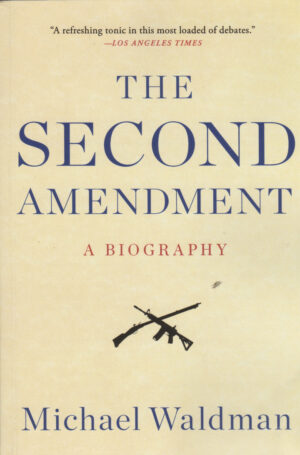
Yes, I am a retired judge. Yes, from time to time in my role hearing matters in Minnesota District Court, constitutional issues arose that required me to research and apply principles of law handed down to us by the Founders in that most precious of legal documents, the United States Constitution. But in 14 years as a prosecutor, 18 years in private legal practice, and 23 years on the Bench (20 active; 3 on senior status) I was never called upon to research the history behind the Second Amendment, the so-called Right to Bear Arms addition to our Constitution as part of the original 10 amendments, the Bill of Rights. As a lawyer, historian, political scientist, judge and yes, gun owner, I thought it was time I learned the basics. This is the book I selected from the hundreds available on the topic of how and why the Second Amendment came to be. I am glad I took the time to breeze through this relatively brief tome.
Waldman takes us back to the debates surrounding the adoption of the Bill of Rights, zeroing in on the discussions held, both in writing and orally, amongst the Founders and Framers of our constitution. The gist of the beginnings of the Second Amendment are very simple: there was a faction of American men of power who believed that state militias, the essence of the new republic’s military force during its insurrection against England, had to be recognized and preserved against the Federalist forces supporting a national army and navy. Why so? The so-called Anti-Federalists, men like George Mason, feared that a central government controlling a national military would abrogate and erode states’ rights, perhaps to the degree where the republican dream of the American experiment would devolve into a substitute monarchy led by war hero, George Washington. The author makes the pointed and well-supported argument that there was virtually no discussion, amongst the opposing camps, regarding an individual citizen’s right to bear arms at the time the Constitution was written, or subsequently, when the Bill of Rights were adopted. If one looks at the original thirteen colonies that formed our “more perfect union”, the individual states had a plethora of regulations relating to arms; including the primitive firearms of the day. There were restrictions against carrying arms openly; restrictions against Blacks owning and possessing firearms; and a host of other regulations that were not, upon the passage of the Second Amendment, abrogated by federal power.
Waldman then takes us on a winding and tortured path beginning with the single sentence of the Second Amendment, A well regulated militia, being necessary to the security of a free state, the right of the people to keep and bear arms, shall not be infringed, to the first case to declare, by edict of our present Activist Conservative Supreme Court, that those words, originally written to allow states to be free of federal oppression via “well regulated militias”, somehow abrogate virtually all regulations or restrictions applicable to an individual’s right to own a gun. Heller, the case that turned what had been the commonly understood power of states and local governments to regulate firearms for the purpose of public safety, was not decided until June of 2013 when “originalist” jurist, Antonin Scalia, declared for the majority of the United States Supreme Court that there existed, for the first time in a decision of the Court, a virtually unrestricted individual right to own and possess nearly any type of firearm. It is the originalist label that Waldman critiques in great depth, making it clear, from history and the prior decision of the supreme court, that such a label is merely a subterfuge given the original debates over the Second Amendment did, in no way, support such an edict. Those, like Scalia (who has passed on but whose legacy lives in the present Conservative Activist majority of the court) who bemoaned and berated the advancement of rights and powers not enumerated in the Constitution or its Amendments (which would, be extrapolation, include privacy rights supporting the right to procure birth control, the right to marry across ethnicities, the right to marry a person of the same gender, and of course, the right to procure an abortion (which is now relegated to the various states); as well as the right to associate (to join groups such as the Boy Scouts or the KKK)) are no different than the philosophical stretch utilized by the Burger Court to legalize the right to abortion in its own time. In essence, what we are facing today is the blow-back by neo-conservative jurists who were and are affronted by virtually every progressive piece of federal legislation from the New Deal to Joe Biden. Making things even more depressing, the jurists taking such stands in federal courts across the land are appointed for life: They are not subject to the will of the people even when the decisions of the courts impede the right of the citizenry, by majority vote, to regulate gun ownership through legislative enactment.
Waldman leaves us with the observation that perhaps Congress can pass legislation to deal with the issues left unanswered by Heller in terms of gun safety and gun control. But of course, that optimism was penned before the present term of the court and the total polarization of American politics. Well written. Insightful. Damn depressing.
Peace
Mark
4 and 1/2 stars out of 5.


